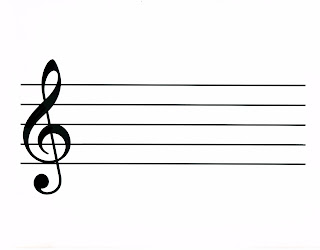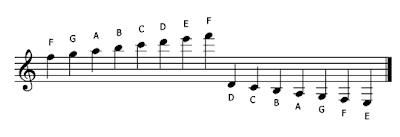Before we get into the next lesson, it has occurred to me that we need to look more closely at the staff for a moment. The 2 previous lessons can be played using only the tab notation provided below the staff. However, for those of you wishing to learn how to read standard musical notation (which I highly recommend!), the use of tab notation merely delays your education.
Look again at the treble clef staff. Notice that it has 5 horizontal lines & 4 spaces. A notes can be written either on a line or in a space. And each line or space refers to a particular note. Everything that you need to know to play a piece of music happens with this image.
There are 7 natural notes in western music - A, B, C, D, E, F & G. And they all fall on the staff pictured above, with lower pitched notes occurring lower on the staff & higher pitched notes occurring higher on the staff. Here are the notes of the treble clef staff:
The notes on the lines of the staff are E, G, B, D & F. You can remember them easily using this simple sentence: Every Good Boy Does Fine. The notes that fall within the spaces are F, A, C &E. They can be remembered easily too. They simply spell out FACE.
So knowing only what you know just from these 2 graphics, you can already say that E on the bottom line is a lower note than F in the first space & D on the 4th line is a higher note than A in the second space. And you can say this without having any idea what these notes really sound like. It's just how things are on the staff.
Now you might be saying to yourself: "Hey wait a second! There must be more than just 7 notes in music." And you would be right. The staff continues above & below the image above, using what we call ledger lines to represent notes above or below the treble clef staff. Here is an example of ledger lines:
See how they continue above & below the staff? So far, every note we've played has been found on the staff. But a time will come very soon when we will have to escape the staff & use some ledger lines to play through our lessons. But that's still a lesson or two away, so don't worry about it too much yet.
Where do the notes of a guitar fall on the staff? Here is an example using only the open six strings:
Notice in the first 2 measures that the open 6th string & the open 5th string have ledger lines. Those 2 notes are represented below the staff due to their low pitch. But since we've only played notes on the 1st & 2nd strings, we haven't made use of ledger lines yet. The six notes we've learned have all been on the staff. Here's what they look like together:
Try playing through this exercise. Notice the funny squiggle at the end of the 3rd measure & again at the end of the 6th. It's called a "rest". A rest means you don't play on that beat. Read the notes on the staff as you play, even if you're primarily using the tab notation. The notes are B, C, D, E, F, G, F, E, D, C & B (rest) followed by G, F, E, D, C, B, C, D, E F & G (rest). Simple isn't it? Work on playing through this exercise cleanly & using an up/down picking motion. Then, when you feel confident enough, try increasing your speed. And we'll learn about the 3rd & 4th strings in the next lesson. Rock on!





No comments:
Post a Comment